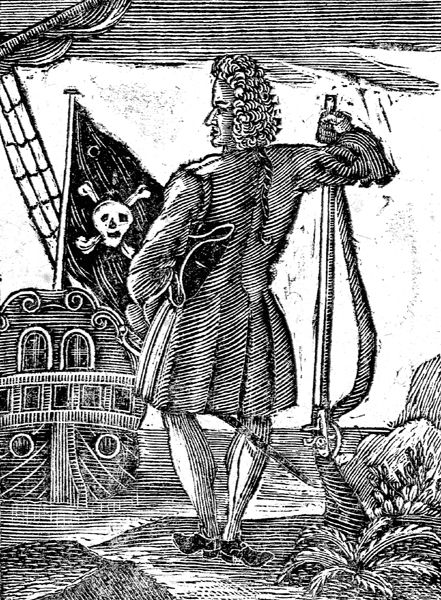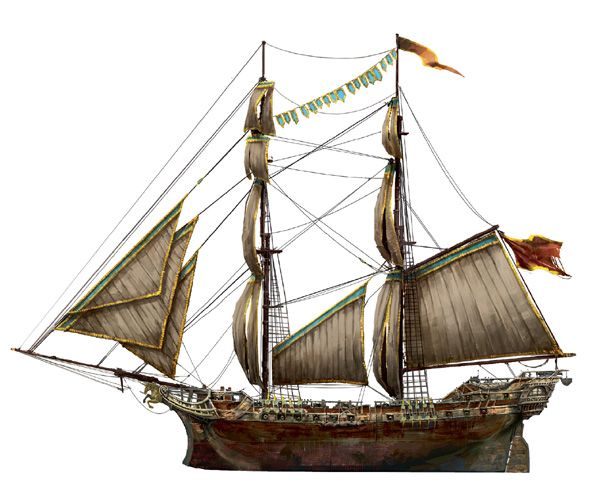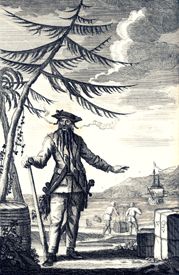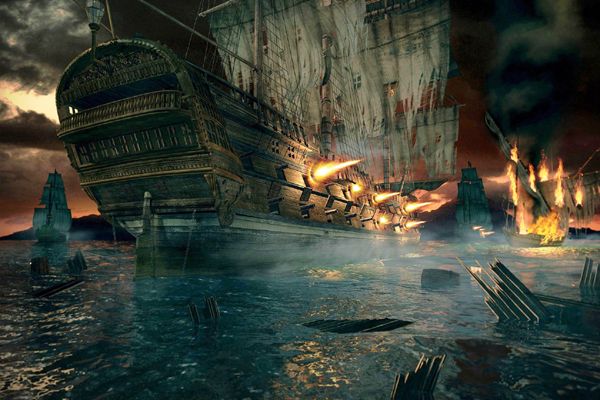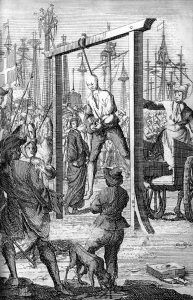By Hugh F. Rankin in 1960
The story of Major Stede Bonnet’s career is indeed a strange one. He had less cause than most to become a pirate. His background was much more respectable than that of the average sea rover. His had not been the rough-and‑tumble life usually bred by poverty and hunger, which had led so many men to turn pirates. Even more astonishing, he had never even been a sailor!
In England, his family was held in high esteem, and his education was good for the age in which he lived. As an army officer, he had reached the rank of major, but after reaching middle age, he had settled down to enjoy the good things of life. He enjoyed the company of the best society of Bridgetown on the West Indian Island of Barbados. His sugar plantation brought him wealth, and he held the respect of his friends and neighbors.
Then, for some undetermined reason, Stede Bonnet suddenly cast aside everything smacking of respectability and, as a pirate, began the search for adventure. His former neighbors were scandalized when they discovered this most likable person had suddenly gone “a pyrating.” They searched for an explanation for his unusual behavior. Publicly, they vowed the major was suffering from “a Disorder in his Mind.” There were whispers that the real reason for his about-face was the sharp tongue of a nagging wife. Some openly stated that Bonnet’s troubles could be traced to “some discomforts he found in the married state.”
Not only was Stede Bonnet not familiar with the ways of the sea, but he was unaware of the ways of pirates. The beginning of his piratical career was much milder than that of the ordinary buccaneer. In the first place, he did not attempt to capture or steal a ship with which to begin his operations. In early 1717, he did the almost unheard-of thing of buying a vessel. This was a fast little sloop, with ten cannons lashed to her single-gun deck. He renamed his ship the Revenge, a favorite name among pirates. In selecting his crew, his course was equally startling. Instead of signing on a crew and promising them regular shares of the booty, Bonnet hired his sailors, paying them wages out of his own pocket. From Bridgetown’s taverns and grog shops, he recruited some 70 derelict seamen to man his ship.
Despite the innocent manner in which he prepared for a life of piracy, Bonnet did demonstrate that he had planned carefully. He did not sail right out and start plundering vessels in the nearby sea lanes. Instead, the Revenge lay quietly rocking in the harbor for several days. To those who asked, the captain replied that he had purchased the sloop to work up trade with other nearby islands. Then, one night, without a word of farewell to his friends or the whining Mrs. Bonnet, the captain ordered the anchor to be weighed, and the Revenge slipped quietly across the Bridgetown bar out into the vastness of the open Atlantic. Once out of sight of land, a course was set for the Capes of Virginia. Once there, he stationed himself in that great sea lane of commerce.
For a rank amateur, Bonnet was highly successful. Within a few days, he had taken the Anne of Glasgow, the Endeavor of Bristol, the Young from Leeds, and the Turbes from Barbados. After plundering the cargo, the crews were set ashore to be picked up by some passing vessel. The Turbes was burned, more than likely because she was from Barbados. This seemed to set a pattern, for every ship from Barbados that Bonnet later captured was put to the torch, probably to keep the news of his new profession from reaching his former home.
Sailing north, Bonnet discovered a ready market in New York for the booty taken from his prizes. More importantly, the merchants who bought the goods asked no embarrassing questions. A sloop bound for the West Indies was captured, but hunting in the northern Atlantic proved not as profitable as in southern waters. After putting into Long Island to take on supplies, Bonnet steered southward, this time for the Carolina coast.
The Revenge hove to off the entrance to Charleston harbor, lurking in wait for ships entering or leaving that port. Success came quickly. Almost immediately, a sloop and then a brigantine sailed into view. Both were quickly taken. The brigantine was robbed of its cargo and then released. The sloop, from Barbados, with its hold filled with “sugar, rum, and negroes,” was kept, but the crew was released. Then, turning north again, Bonnet sought sanctuary in one of North Carolina’s hidden inlets. The Barbadian sloop was burned, after which the Revenge was careened and her hull scraped.
With his ship slipping easily through the waves, Bonnet cleared the North Carolina coast and sailed for the Bay of Honduras, a noted pirate rendezvous. But all was not tranquil aboard the Revenge. The captain’s inexperience was beginning to show. The crew had discovered quite early that the master of their vessel knew little or nothing about nautical operations. They grew surly and unruly. Say what you will about Stede Bonnet; he was courageous. He determined that speedy and stern discipline was the formula for putting down an open rebellion, and the slightest instance of insubordination was quickly punished. Yet when the pirates dropped anchor in the Bay of Honduras, the murmurs of discontent were flying faster between the crew members.
Another Revenge moored in the bay, the Queen Anne’s Revenge. This was the ship of the notorious Blackbeard, known as the fiercest pirate operating in North American waters. This strange pair of captains struck up a friendship and decided that they would cruise together. They charted a course and soon were heading out to sea.
They had covered only a short distance before Blackbeard discovered “he had caught an odd sort of fish.” No matter how successful Bonnet had been in the past, his lack of seamanship would be a handicap. Blackbeard did not relish working in partnership with an amateur. So he invited the other captain over to the Queen Anne’s Revenge. Once Bonnet stepped on board, he almost became a prisoner. Blackbeard flattered him by saying that as a man of education and cultured background, it was not fitting that he should be forced to endure the hardships of command. It was much better that the major should enjoy a life of ease aboard Queen Anne’s Revenge. Bonnet knew what was meant, but he could do nothing except reproach himself for being a fool in joining up with another captain. One of Blackbeard’s lieutenants, Richards, was given command of the Revenge. Richards, a man more to the liking of the pirates, soon put down any thought of mutiny among the sailors.
Bonnet continued in enforced idleness aboard Blackbeard’s ship. The cruise covered the sea lanes between the Bahamas and South Carolina and was more than successful. At least 12 ships of varying sizes were taken. Some of the ships were kept. Several sailors aboard the captured prizes were allowed to sign on with the pirates. By the time Blackbeard set sail for North Carolina, he was the admiral of a flotilla with four ships and at least 140 seamen under his command. Although he was to receive a captain’s share in the booty, Stede Bonnet still fretted in his cabin. He could not be content until he was master of his own ship once again.
His opportunity came earlier than he had expected. Blackbeard’s fleet arrived in North Carolina’s Topsail Inlet in June 1718. Two of the ships ran aground. The pirates began to quarrel among themselves. Dissension spread from one ship to another. As the tension mounted, Blackbeard notified Bonnet that he was willing for him to assume the command of the Revenge once again.
Because of the successful cruise, many of the pirates now had more money than ever before in their lives. They wanted to quit piracy. This decision was made easier when it was learned that King George I had extended his proclamation of the year before, granting pardon to all those pirates who would take the oath of allegiance. At the same time, it was also learned that war had now broken out between England and Spain. Privateers would be needed. Putting these two bits of information together, Bonnet realized that not only would he be granted forgiveness, but he would also be able to continue plundering ships as a legal naval representative of England.
Leaving the Revenge under the command of a subordinate officer, he hurried to the town of Bath and surrendered himself to Governor Charles Eden there. After receiving the oath from Bonnet, the Governor also permitted him to sail to the Island of St. Thomas in the West Indies. There, he could secure a Letter of Marque and Reprisal, or commission as a privateer, from the Governor of that island. In other words, this would make Stede Bonnet, in effect, a legal pirate.
Back at Topsail Inlet, he discovered that Blackbeard had pulled a double-cross. The Revenge was safe, but some other ships had been sunk, and Blackbeard had put out to sea with all the plunder, including the shares belonging to Bonnet and his men. It was also learned that 17 men who had opposed this action had been stranded on a desolate sand bar without food, water, or means of escape. They avoided a lonely death when Bonnet rescued them after two days and nights. Several others, who had fled to escape the fury of Blackbeard, were found hiding in a nearby settlement on the mainland.
Blackbeard had stripped the Revenge of much of her equipment, and provisions were low. Small boats began to bring food out from the shore. From one of these, loaded “with apples and cider to sell,” it was learned that Blackbeard, with a crew of only 18, was now anchored in Ocracoke Inlet. The desire to take revenge against Blackbeard was strong amongst the crew of the Revenge and their captain. Piling on the sail, they steered for Ocracoke. When they arrived at their destination, disappointment awaited them. They heard Blackbeard had sailed northward up the coast just a few hours earlier. The pursuit was renewed. But, the chase was in vain. Blackbeard had escaped them.
With supplies again running low, Bonnet headed for the Virginia capes. A small ship was overhauled, and pork and bread were taken. It seems that Bonnet had not yet decided to return to piracy, for upon this occasion, he paid the captain for these items. Two days later, his attitude had reversed itself. Almost within sight of Cape Henry, a sloop was halted and boarded. Not only did he make no offer to pay the master for supplies, but the ship was sunk, and the crew put ashore. This action clearly indicated that Bonnet had forsaken the idea of privateering and was returning to the old life.
His cruise with Blackbeard had been in the nature of education. From then on, a streak of cruelty appeared in Bonnet’s character. His prisoners were sometimes subjected to torture, and it has been said that he was the only pirate who forced his prisoners to walk the plank. He was now a most forceful character, and there seems to have been little opposition to any of his measures from his crew members. Indeed, they protested little when he announced his intention of flying the Jolly Roger again. His first voyage was to be up the coast towards New England.
To escape the consequences of accepting the King’s pardon and then resuming his piratical activities, the major changed his name. From then on, he insisted on being addressed as “Captain Thomas.” In a like manner, he seemingly defied English authority by renaming the Revenge as the Royal James. Supposedly, this was in honor of the Chevalier de St. George, the son of the banished English king, James II. This prince was at this time in Europe plotting to overthrow the government of George I and regain the throne of England.
On the first cruise under its new name, the crew of the Royal James captured at least ten prizes between Chesapeake Bay and the Delaware Capes. A more than reasonable “profit” was realized from selling their cargo. But the Royal James had begun to leak. She was badly in need of careening and a general overhaul. A course was steered southward, with the intended destination as the Cape Fear region of North Carolina.
The general area near the mouth of the Cape Fear River had become something of a favorite rendezvous for pirates. The complicated terrain and wandering waterways offered concealment from prying eyes. Then, too, Governor Eden of North Carolina was fast gaining a reputation as being friendly to buccaneers.
The careening of the Royal James brought disturbing information. The ship was in such condition that the repairs might take the better part of two months. In their haste to ready their vessel for sea, Bonnet and his crew became careless. A shallop was captured and broken up, and the lumber was used for repairs. The crew was released. This was a mistake, for they spread the word that a pirate was laid up in the lower Cape Fear.
The activities of Bonnet and his kind had long been a thorn in the side of the people of South Carolina and of Charleston in particular. Not only had the pirates been responsible for the disruption of the commerce of the port, but Blackbeard had aroused their anger by making insolent demands upon the city. Governor Eden of North Carolina could hardly be expected to aid in stamping out the pests. The rumors were that not only was his secretary, Tobias Knight, in league with the freebooters, but it was also likely that the governor himself was involved. With no prospect of cooperation from North Carolina, Governor Robert Johnson of South Carolina planned an expeditionary force to wipe out the pests — if he could find the right man to command such an effort.
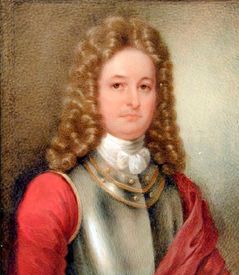
Colonel William Rhett
He had not far to look. Colonel William Rhett, the receiver-general of the colony, came forward and offered his services. The necessary commissions were issued to Rhett. Two sloops, the Henry and the Sea Nymph, were pressed into service. Each ship mounted eight guns. Seventy men comprised the crew of the Henry, while the smaller Sea Nymph could accommodate only 60. Provisions were loaded aboard both vessels. The leaders began to map out a campaign against the pirates in Cape Fear.
There was a sudden change in plans. Even while these last-minute preparations were being carried forward, a sloop from the West Indian Island of Antigua scurried into the harbor. Her skipper brought alarming information. The infamous Charles Vane, he reported, had stopped him near the entrance to the port and had plundered his cargo. Two other ships had met the same fate. Vane, he said, commanded a twelve‑gun brigantine and a crew of 90 men. And he had been overheard to say that he intended to drop down the coast south of Charleston to repair his vessel. Almost immediately, Rhett cleared the harbor to take up the pursuit. He was doomed to disappointment. Instead of sailing southward as reported, Vane had actually turned northward. Rhett did not discover this until he had wasted considerable time in a futile search along the south shoreline of lower South Carolina.
Realizing that the pirate had given him the slip, Rhett was now determined to carry out his original plan and go after the pirates reported at Cape Fear. After all, he reasoned, this might be Vane himself. On September 26, 1718, the great headland of Cape Fear was sighted. The two sloops beat their way into the mouth of the Cape Fear River. Misfortune dogged their heels. Even experienced pilots were not familiar with all of the many sandbars that cluttered the mouth of the river. Neither Rhett nor any of his men were familiar with these shoals. They had no more than entered the stream when their ships shuddered to a stop. They were aground.
But the enemy was in sight. Even before Rhett’s ships ran aground, the topmasts of Bonnet’s Royal James could be seen silhouetted above the trees on the point of land farther upstream. Nothing could be done until after midnight when the high tide would refloat the South Carolina sloops. Then it would be dark. No attack could be made before dawn. Nevertheless, time was short, and the intervening hours were spent clearing the decks for action.
It was impossible to keep their presence a secret. But, it was nearly sundown when the pirates discovered the newcomers, and gathering dusk made it impossible to determine whether they were likely prizes or potential enemies. Bonnet ordered two boats over the side to investigate. They returned with disheartening news. The grounded sloops were heavily armed and carried fighting crews. Daybreak was sure to witness a battle to the death.
All that night, the sounds of battle preparations aboard the pirate ship filtered through the darkness to Rhett and his own busy crew. The desperate and perhaps frightened Bonnet drove his men with alternate threats and curses. Sometime during the night, he went below to his cabin and addressed a raging letter to Governor Johnson. If he came out of this fight alive, he wrote, he would plunder and burn every ship that had the audacity to leave Charleston. Completing this insolent threat, he returned to the deck to drive his men. By the next morning, both Rhett and Bonnet were ready to do battle.
Dawn broke. The sleepy South Carolinians could hear the rattle of anchor chains, and above the trees, they could see the flapping sails as they were run up the masts aboard the Royal James. The pirates were preparing to carry the fight to the enemy. Bonnet’s strategy was to force his adversary into a running fight and then force his way into the open sea, where there was greater opportunity for escape.
Rhett guessed this. Anchors were quickly weighed, and the Henry and the Sea Nymph bore in, trying to force the Royal James into the shallow waters near the shore. All three ships blasted one broadside after another, firing their cannon as quickly as they could be reloaded. Rhett’s cunning paid off. The pirate ship stopped on the sandy bottom of the river. The attackers closed in but soon lost the advantage. They had maneuvered too recklessly, and they, too, were stuck tightly on one of the hidden shoals. It would be another five hours before the tide would refloat any of the three vessels.
The Sea Nymph, which had been attempting to cut off the flight of the pirates, was grounded too far downstream to be of any aid. The Henry was within pistol-shot of the Royal James, and this proved to be unfortunate. When the ships had run aground, they had both careened in the same direction. This position offered protection to the buccaneers, but the canted deck of the Henry exposed her crew to the fire of Bonnet’s men. In the face of this danger, the South Carolinians stood the test of courage. Despite the rain of shots from the pirates, they managed to bring all their guns to bear upon the enemy and began to send cannonballs crashing through the hull.
Nevertheless, the pirates were jubilant. The helpless position of the Henry, they felt, would soon lead to its destruction. During lulls in the firing, they shouted taunts across the water, inviting Rhett’s men to come aboard — if they dared. And, as one of the South Carolinians later said, they “made a wiff in their bloody flag.” The crew of the Henry refused to be dismayed. They answered the derisive shouts with cheerful huzzas,” and promised they would soon be on board, and much too soon for comfort. The firing continued from both ships.
The tide turned. All three vessels held fast. The water slowly deepened across the sandbars. Then, to the terror of the watching pirates, the Henry began to slowly right herself. The crew broke out with a resounding “Hurrah!” All was consternation aboard the Royal James as her crew worked feverishly to refloat their own ship. Their will to fight faded rapidly as the Henry became seaborne. The pirates crowded around Bonnet, demanding that he surrender immediately before they were blown out of the water. The enraged captain angrily vowed he would fire the powder magazine himself and blow up his own ship before he would surrender. Brandishing his pistols, he swore we would blow out the brains of any man who refused to fight with the last ounce of his strength. His firm determination met an equally stubborn resistance among the members of his crew. The pirates, brave only when victory was certain, chose to take their chances with a court trial or perhaps even a pardon.
This heated exchange of words had consumed time. During this period, Rhett had been hastily making repairs to his sloop. Rigging that pirate cannonballs had ripped apart was hurriedly spliced again. A quick inspection of the Henry’s hull assured the captain that his ship was seaworthy. A course was steered for the Royal James. Rhett hoped to bring his ship alongside that of the pirates and board it for a fight to the finish. Suddenly, to the astonishment of the South Carolinians, the white flag of surrender fluttered up the mast of Bonnet’s ship. After a few minutes of negotiations, shouted back and forth across the water, the pirate captain agreed to surrender unconditionally. Only then did the Colonel discover that the “Captain Thomas” he had been fighting was the more notorious Stede Bonnet.
The victory had not been won easily. Onboard the Henry, ten men had been killed and 14 wounded (some of whom later died). Before she had been forced out of the fight, the Sea Nymph had suffered casualties of two men killed and four others wounded. Seven pirates lay dead aboard the Royal James. Five others were wounded, two of whom later died of injuries.
On October 3, 1718, the vessels of the victorious Rhett and their prize limped back into Charleston harbor “to the great joy of the whole Province.” Cheerful shouts of celebration rang through the town. But there were still problems ahead. Among them was the fact that, at this time, Charleston did not have a public jail. There was some difficulty in obtaining a place in which to confine the prisoners. The crew of the Royal James was placed in the public watchhouse, or guardhouse, under a heavy military guard. The imprisonment of the pirate captain presented still another problem. It was generally known that Bonnet was a gentleman by birth, and the social customs of the day prohibited the jailing of a gentleman in the same place as common criminals. As a result of this consideration, the Major was placed in the custody of the town marshal, who permitted the pirate captain to stay in his own home. Two sentinels were assigned to guard the marshal’s residence. Several days later, two others of the crew of the Royal James, David Herriot, sailing master, and Ignatius Pell, boatswain, were placed in the same house with their former chieftain. Both had agreed to turn the king’s evidence, and it is possible they were separated from their former comrades to save them from injury.
The people of South Carolina seemed determined the buccaneers would receive their just due. The date for the trial was set for some four weeks distant. This allowed the Assembly of the Province time to pass “An Act for the more speedy and regular trial of pirates.” Yet, strange as it seems, and in the face of this obvious determination of the citizens of the community, it developed that Bonnet had a number of influential friends in Charleston. There is no evidence pointing to their identity, but they were successful in terrorizing a number of the good citizens of the town. Still, they were unable to free Bonnet. Bribery accomplished what terror had not been able to. Gold was waved before the eyes of the two sentinels guarding the marshal’s house. On October 25, just three days before the trial, the city was shocked to discover that Bonnet and David Herriot had escaped. It has been said that Bonnet had slipped out of the house while wearing women’s clothes. Ignatius Pell, the other pirate in the house, had preferred to take his chances at the trial and a possible pardon and had remained behind.
Governor Johnson acted quickly. Fast action was necessary if the fugitives were to be apprehended before they reached North Carolina or managed to secure a boat. A reward of £700 was posted. Colonel Rhett was placed in command of a group selected to pursue the escapees.
Bonnet’s escape had been well planned. A boat had been waiting. He was also joined by several other persons who wanted to become pirates. They attempted to sail northward, possibly for North Carolina. The winds were against them. After a vain attempt to beat their way against the contrary breezes, they stole back into Charleston harbor to replenish their supplies. They landed and hid out on Sullivan’s Island, just a few miles from the city and almost directly across the bay from it.
It was impossible to conceal their return. Just as soon as Rhett learned of their whereabouts, he waited until after dark and landed on the island. The pirates had concealed their camp carefully. Rhett’s men spent several hours slowly searching through the tangles of low myrtle that covered the low sand dunes. Finally, near the upper end of the island, the buccaneer’s encampment was sighted. Taking no chances on their escaping, Rhett’s men immediately opened fire. Herriot was killed instantly. A black man and an Indian belonging to Bonnet’s gang fell, severely wounded. The pirate captain surrendered without resistance. Upon the prisoner’s return to Charleston, he was placed in safer confinement.
In the meantime, on October 28th, Bonnet’s crew from the Royal James had been brought to trial before the Vice-Admiralty Court. The presiding judge, Nicholas Trott, had a reputation for being a man of little mercy. No juries were in Vice-Admiralty Courts, and a lawyer did not represent the prisoners. This was an age when the legal profession was not highly esteemed, and it was considered “a base and vile thing to plead for money or reward.” The only defense the cringing prisoners could muster was that they had been forced into piracy by Stede Bonnet. The evidence against them was too overwhelming, and there was Ignatius Pell, who now turned against his former comrades and offered testimony detailing the events of their piratical careers. Judge Trott refused to listen to the weak excuses offered by the defense. In a stern speech sprinkled with Biblical quotations, he pronounced their doom. All were sentenced to hang except Ignatius Pell, who had turned King’s evidence, and three others who had been able to prove they had been forced to become members of the crew against their will.
On November 8, 1718, the 29 condemned rogues were taken down to the gallows erected at the water’s edge on White Point. There, they were hanged. As a lesson to those who might be inclined to follow a similar career, their bodies were left hanging and “dancing in the four winds” for several days. Afterward, they were taken down and buried at the marsh’s edge below the low watermark. The ebb and flow of the tide soon erased all evidence that they had ever spent any time on this earth.
Two days after the gruesome scene on White Point, Bonnet was brought to trial. Although his answer to the charges was “not guilty,” the pirate made little or no defense on his own behalf. Judge Trott again had the opportunity to thunder out a sentence of death by hanging. In his final speech, the judge reviewed all of Bonnet’s past misdeeds. He pictured the hereafter of the pirate as suffering all the tortures of hell, “in the lake which burneth with fire and brimstone, which is the second death.” Surely this man roared Trott would suffer the “everlasting burnings.”
Governor Johnson designated December 10, 1718, as the date for the execution. Stede Bonnet, a former soldier and bold pirate, now became no more than the shadow of a man. He became a groveling thing, living out his few remaining days in abject terror and agony. Despite his bloody past, the fickle sympathies of the same public who had once so feared him were aroused again, this time on his behalf. Several of these citizens petitioned Governor Johnson to either pardon or commute the sentence of the former pirate. Some suggested that he be sent to England, where the British government might review his case. Bonnet spent most of his time writing pathetic letters. One such desperate message was addressed to Colonel Rhett, the man who had twice captured him. So pitiful was this plea that Rhett offered to accompany the prisoner to England in an attempt to gain a new trial if the governor would give his consent.
The governor stood firm. Bonnet had broken his word before. A few days before the hanging, the terrified pirate addressed one last plea to the governor. With pen dipped in fear, he wrote:
“I once more beg for the Lord’s Sake, dear Sir, that as you are a Christian, you will be as charitable as to have Mercy and Compassion on my miserable Soul but too newly awakened from a Habit of Sin to entertain so confident Hopes and Assurances of my blessed Jesus, as is necessary to reconcile me to so speedy a Death; wherefore as my Life, Blood, Reputation of my Family, and future happy State lies entirely at your Disposal, I implore you to consider me with a Christian and charitable Heart, and determine mercifully of me that I may ever acknowledge and esteem you next to God, my Saviour; and oblige me ever to pray that our heavenly Father will also forgive your Trespasses.”
Governor Johnson stood steadfast in his resolution that the pirate was to hang. On the day appointed for the execution, Bonnet was brought from his place of confinement in a state near collapse. One observer noted that “he was scarce sensible when he came to the place of execution.” A few minutes later, holding a cluster of flowers in his manacled hands, Stede Bonnet was “swung off” the cart beneath the gallows. When his body was cut down, it was taken down to the edge of the marsh and there buried below the low water mark, near the graves of the former members of his crew.
So ended the life of Major Stede Bonnet, a gentleman pirate. No stone marked his grave, and the sea waters on which he had won his reputation soon washed away all traces of his final resting place.
By Hugh F. Rankin, The Pirates of Colonial North Carolina, North Carolina Department of Cultural Resources, 1960. Compiled and edited by Kathy Alexander/Legends of America, updated January 2024.
This article was excerpted from The Pirates of Colonial North Carolina, a publication of the Historical Publications Section, Division of Historical Resources, Office of Archives and History, North Carolina Department of Cultural Resources. The author, Hugh F. Rankin (1913‑1989) was a noted historian of colonial America and the American Revolution and a history professor at Tulane University from 1957 to 1983. He was the author or co-author of well over a dozen books on historical subjects and many journal articles. Today, this booklet is in the public domain as its copyright was not renewed. Though the context of the article has not changed, some minor editing has occurred.
Also See:
Blackbeard – The Fiercest Pirate of Them All

